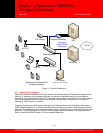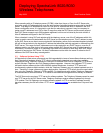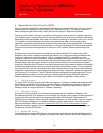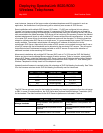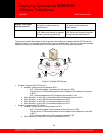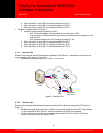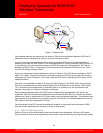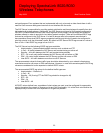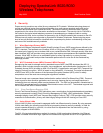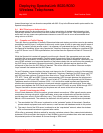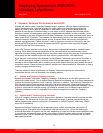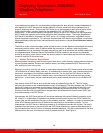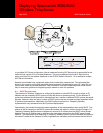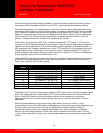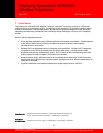
Deploying SpectraLink 8020/8030
Wireless Telephones
May 2009 Best Practices Guide
to locate and register with the Telephony Gateway. Once the handset registers, the remaining options
that would normally be handled via DHCP, such as TFTP, are provided by the Telephony Gateway.
When the license option in the wireless phone is set for one of the IP protocols the handset will require
several other DHCP options in order to function properly. In addition to the base DHCP options required
by the Telephony Gateway implementation the handset will also require DHCP options 151 and/or 152.
Option 151 is specifically the IP address of the Registration SVP Server. Option 152 is for deployments
that are running an OAI Gateway where the option field is populated with the IP address of the OAI
gateway. These options are only accepted as IP address by the handset.
DHCP Option 66, as defined by RFC 2132, provides the address of a TFTP server. A TFTP server is
required for any SIP implementation and is only required in other IP protocols when software updates are
needed. It is recommended that a TFTP server be made available regardless of the implementation. In
SRP deployments the Telephony Gateway can act as a TFTP server but it is only capable of servicing a
single handset at a time. Additionally it is not possible to use the Telephony Gateway TFTP server to
provide software to the handsets. Because of these limitations an external TFTP server is advisable and
is often required in order to serve multiple clients at once.
Additional DHCP options are supported on the SpectraLink Wireless Telephones and can be configured
in the DHCP scope appropriate for the IP scope servicing the phones. See the Table 5 for the list of
DHCP options typically used and their purpose.
DHCP
Option
Value Expected Purpose
1 IP Address (i.e. 255.255.255.0) Subnet Mask
3 IP Address (i.e. 192.168.1.1) Default Gateway
6 IP Address (i.e. 192.168.1.10) DNS Server
7 IP Address (i.e. 192.168.1.20) Syslog Server
15 String (i.e. mycompany.com) Domain Name
42 IP Address (i.e. 192.168.1.30 NTP (Network Time Protocol)
66 IP Address (i.e. 192.168.1.40) TFTP Server
151 IP Address (i.e. 192.168.1.50) SVP Server
152 IP Address (i.e. 192.168.1.60) OAI Gateway
Table 5 – DHCP Options
Depending on the IP protocol implementation additional DHCP options will be required to support the call
server. The options will likely include additional TFTP server addresses and the IP address of the call
server. These DHCP options should be provided by the call server manufacturer to ensure the
appropriate information and values required for those options are correct for the specific IP protocol
deployment.
While the wireless telephone does support using a DNS server, as shown in Table 5, it is not
recommended to do so. Using DNS creates a dependency on a service that may not be reliable when the
services a phone provides can be critical. By using DNS there is also the addition of latency in
transactions that the handset must complete with the DNS server which could lead to undesirable
behavior from the wireless telephone. Please note if DNS is necessary then DHCP option 15 is also
required. Without both DHCP options 6 and 15 the wireless telephone will not be able to complete DNS
queries
30
©2009 Polycom, Inc. All rights reserved.
Polycom and the Polycom logo are registered trademarks of Polycom, Inc. All other trademarks are the property of Polycom, Inc. or their respective companies.



